 |
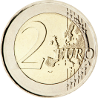 |
C o m m e m o r a t i v e C o i n s | ||
| France | |||||||
The edge lettering on the French 2‐Euro‐commemorative coins is : |
 |
||||||
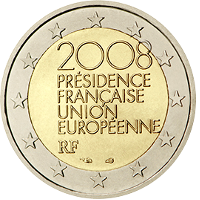
|
 |
France | French Presidency of the Council of the European Union | 20001 |  |
Volume : 20,084,936 Date of Issue : 01 Jul. 2008 Designer : Philippe Starck Mintmaster : Hubert Larivière (Mintmark = a hunting horn with the sign of the zodiac of Pisces) Producer : French mint Monnaie de Paris in Plessac (Mintmark = cornucopia) |
|||||
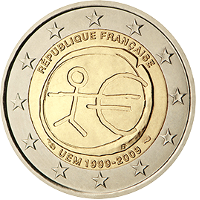
|
 |
France | 10 years of Economic and Monetary Union (EMU) | 20001 |
 |
Volume : 10,074,085 Date of Issue : 23 Jan. 2009 Designer : Georgios Stamatopoulos ("ΓΣ") Mintmaster : Hubert Larivière (Mintmark = a hunting horn with the sign of the zodiac of Pisces) Producer : French mint Monnaie de Paris in Plessac (Mintmark = cornucopia) |
|||||
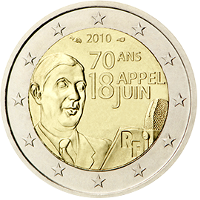
|
 |
France | 70th anniversary of the Appeal of June the 18th 1940 by de Gaulle | 20001 |  |
Volume : 20,032,000 Date of Issue : 25 May 2010 Designer : Nicolas Cazan Mintmaster : Hubert Larivière (Mintmark = a hunting horn with the sign of the zodiac of Pisces) Producer : French mint Monnaie de Paris in Plessac (Mintmark = cornucopia) |
|||||

|
 |
France | 30th anniversary of Fête de la Musique | 20001 |  |
Volume : 10,014,404 Date of Issue : 21 Jun. 2011 Designer : Fabienne Courtiade Mintmaster : Yves Sampo (Mintmark = a pentagon) Producer : French mint Monnaie de Paris in Plessac (Mintmark = cornucopia) |
|||||
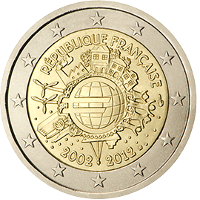
|
 |
France | 10 years Euro‐Currency | 20001 |
 |
Volume : 10,010,994 Date of Issue : 05 Jan. 2012 Designer : Helmut Andexlinger Mintmaster : Yves Sampo (Mintmark = a pentagon) Producer : French mint Monnaie de Paris in Plessac (Mintmark = cornucopia) |
|||||
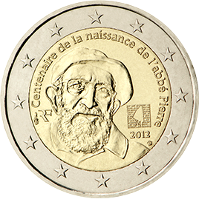
|
 |
France | 100th birthday of Abbé Pierre | 20001 |  |
Volume : 1,020,000 Date of Issue : 24 Jun. 2012 Designer : Yves Sampo Mintmaster : Yves Sampo (Mintmark = a pentagon) Producer : French mint Monnaie de Paris in Plessac (Mintmark = cornucopia) |
|||||
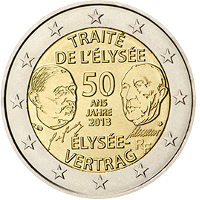
|
 |
France | 50 Years Élysée‐Treaty (Fanco‐German Friendship) Common issue of France and Germany |
20001 |  |
Volume : 10,017,789 Date of Issue : 21 Jan. 2013 Designer : Yves Sampo and Stefanie Lindner Mintmaster : Yves Sampo (Mintmark = a pentagon) Producer : French mint Monnaie de Paris in Plessac (Mintmark = cornucopia) |
|||||
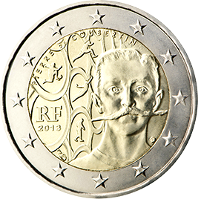
|
 |
France | 150th birthday of Pierre de Coubertin | 20001 |  |
Volume : 1,014,338 Date of Issue : 03 Jun. 2013 Designer : Yves Sampo Mintmaster : Yves Sampo (Mintmark = a pentagon) Producer : French mint Monnaie de Paris in Plessac (Mintmark = cornucopia) |
|||||
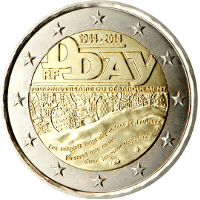
|
 |
France | 70th anniversary of the D‐Day Landings (June 6th 1944) | 20001 |  |
Volume : 3,019,675 Date of Issue : 11 Jun. 2014 Designer : Yves Sampo Mintmaster : Yves Sampo (Mintmark = a pentagon) Producer : French mint Monnaie de Paris in Plessac (Mintmark = cornucopia) |
|||||
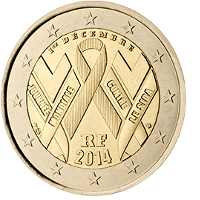
|
 |
France | World‐AIDS‐Day | 20001 |  |
Volume : 3,020,000 Date of Issue : 24 Nov. 2014 Designer : Atelier de Gravures de la Monnaie de Paris Mintmaster : Yves Sampo (Mintmark = a pentagon) Producer : French mint Monnaie de Paris in Plessac (Mintmark = cornucopia) |
|||||

|
 |
France | 70 years of peace in Europe | 20001 |  |
Volume : 4,020,500 Date of Issue : 30 Jan. 2015 Designer : Joaquin Jimenez (Mintmark = a square) Mintmaster : Yves Sampo (Mintmark = a pentagon) Producer : French mint Monnaie de Paris in Plessac (Mintmark = cornucopia) |
|||||

|
 |
France | 225th anniversary of Fête de la Fédération (Federation Festival) | 20001 |  |
Volume : 4,020,000 Date of Issue : 22 Jul. 2015 Designer : Joaquin Jimenez (Mintmark = a square) Mintmaster : Yves Sampo (Mintmark = a pentagon) Producer : French mint Monnaie de Paris in Plessac (Mintmark = cornucopia) |
|||||

|
 |
France | 30 years EU‐Flag | 20001 |
 |
Volume : 4,020,000 Date of Issue : 16 Nov. 2015 Designer : Georgios Stamatopoulos ("ΓΣ") Mintmaster : Yves Sampo (Mintmark = a pentagon) Producer : French mint Monnaie de Paris in Plessac (Mintmark = cornucopia) |
|||||
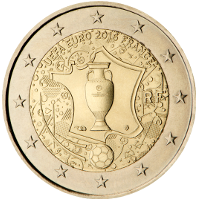
|
 |
France | 2016 UEFA European Football Championship | 20001 |  |
Volume : 10,020,500 Date of Issue : 05 Feb. 2016 Designer : Miguel Viana Mintmaster : Yves Sampo (Mintmark = a pentagon) Producer : French mint Monnaie de Paris in Plessac (Mintmark = cornucopia) |
|||||
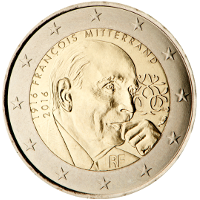
|
 |
France | François Mitterand | 20001 |  |
Volume : 10,020,000 Date of Issue : 12 Sep. 2016 Designer : Joaquin Jimenez Mintmaster : Yves Sampo (Mintmark = a pentagon) Producer : French mint Monnaie de Paris in Plessac (Mintmark = cornucopia) |
|||||
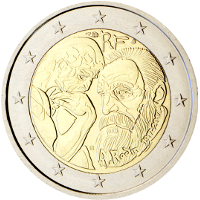
|
 |
France | Centenary of the death of Auguste Rodin | 20001 |  |
Volume : 10,020,500 Date of Issue : 03 Feb. 2017 Designer : Joaquin Jimenez (Mintmark = a square) Mintmaster : Yves Sampo (Mintmark = a pentagon) Producer : French mint Monnaie de Paris in Plessac (Mintmark = cornucopia) |
|||||
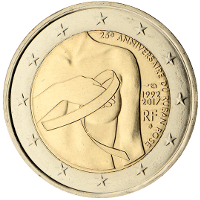
|
 |
France | 25 years of Breast cancer awareness | 20001 |  |
Volume : 10,020,500 Date of Issue : 25 Sep. 2017 Designer : Joaquin Jimenez Mintmaster : Yves Sampo (Mintmark = a pentagon) Producer : French mint Monnaie de Paris in Plessac (Mintmark = cornucopia) |
|||||
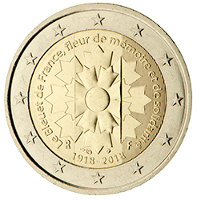
|
 |
France | "Bleuet de France" (The French Cornflower of Remembrance) | 20001 |  |
Volume : 15,020,000 Date of Issue : 19 Feb. 2018 Designer : Joaquin Jimenez Mintmaster : Yves Sampo (Mintmark = a pentagon) Producer : French mint Monnaie de Paris in Plessac (Mintmark = cornucopia) |
|||||

|
 |
France | Simone Veil | 20001 |  |
Volume : 15,021,000 Date of Issue : 26 Jun. 2018 Designer : Joaquin Jimenez (Mintmark = a square) Mintmaster : Yves Sampo (Mintmark = a pentagon) Producer : French mint Monnaie de Paris in Plessac (Mintmark = cornucopia) |
|||||
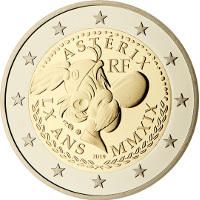
|
 |
France | 60th anniversary of the creation of Astérix | 20001 |  |
Volume : 310,000 Date of Issue : 06 Jun. 2019 Designer : Albert Uderzo Mintmaster : Yves Sampo (Mintmark = a pentagon) Producer : French mint Monnaie de Paris in Plessac (Mintmark = cornucopia) |
|||||
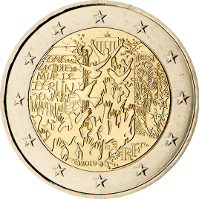
|
 |
France | 30th anniversary of the fall of the Berlin Wall Joint issue of Germany and France |
20001 |  |
Volume : 15,020,000 Date of Issue : 10 Oct. 2019 Designer : Joaquin Jimenez (Mintmark = a square) Mintmaster : Yves Sampo (Mintmark = a pentagon) Producer : French mint Monnaie de Paris in Plessac (Mintmark = cornucopia) |
|||||
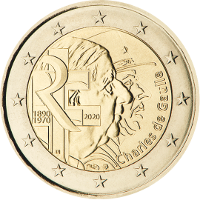
|
 |
France | Charles de Gaulle | 20001 |  |
Volume : 18,061,940 Date of Issue : 31 Jan. 2020 Designer : Joaquin Jimenez (Mintmark = a square) Mintmaster : Yves Sampo (Mintmark = a pentagon) Producer : French mint Monnaie de Paris in Plessac (Mintmark = cornucopia) |
|||||
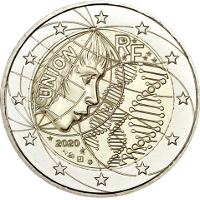
|
 |
France | Medical Research | 20001 |  |
Volume : 310,000 Date of Issue : 27 Oct. 2020 Designer : Joaquin Jimenez (Mintmark = a square) Mintmaster : Yves Sampo (Mintmark = a pentagon) Producer : French mint Monnaie de Paris in Plessac (Mintmark = cornucopia) |
|||||
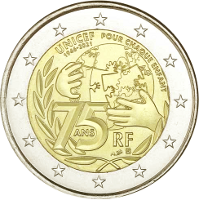
|
 |
France | 75th anniversary of UNICEF | 20001 |  |
Volume : 7,520,000 Date of Issue : 20 Feb. 2021 Designer : Joaquin Jimenez (Mintmark = a square) Producer : French mint Monnaie de Paris in Plessac (Mintmark = cornucopia) |
|||||
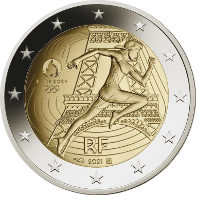
|
 |
France | Marianne and the race ‐ Eiffel Tower 1st coin in the series on the Olympic Summer Games Paris 2024 |
20001 |  |
Volume : 510,000 Date of Issue : 27 Sep. 2021 Designer : Joaquin Jimenez (Mintmark = a square) Producer : French mint Monnaie de Paris in Plessac (Mintmark = cornucopia) |
|||||

|
 |
France | 90th birthday of former President Jacques Chirac | 20001 |  |
Volume : 9,020,000 Date of Issue : 25 Jan. 2022 Designer : Joaquin Jimenez (Mintmark = a square) Producer : French mint Monnaie de Paris in Plessac (Mintmark = cornucopia) |
|||||
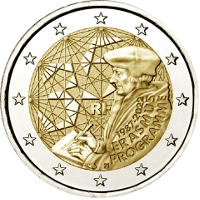
|
 |
France | 35th anniversary of the Erasmus Program | 20001 |
 |
Volume : 3,520,000 Date of Issue : 05 Jul. 2022 Designer : Joaquin Jimenez Mintmaster : Joaquin Jimenez (Mintmark = a square) Producer : French mint Monnaie de Paris in Plessac (Mintmark = cornucopia) |
|||||

|
 |
France | The Genius and the discus throw ‐ Arc de Triomphe 2nd coin in the series on the Olympic Summer Games Paris 2024 |
20001 |  |
Volume : 260,000 Date of Issue : 22 Sep. 2022 Designer : Joaquin Jimenez (Mintmark = a square) Producer : French mint Monnaie de Paris in Plessac (Mintmark = cornucopia) |
|||||

|
 |
France | The Sower and the fist fighting ‐ Pont Neuf 3rd coin in the series on the Olympic Summer Games Paris 2024 |
20001 |  |
Volume : 260,000 Date of Issue : 10 Jan. 2023 Designer : Joaquin Jimenez (Mintmark = a square) Producer : French mint Monnaie de Paris in Plessac (Mintmark = cornucopia) |
|||||

|
 |
France | Rugby Union World Cup ‐ France 2023 | 20001 |  |
Volume : 15,120,000 Date of Issue : 04 Jul. 2023 Designer : Joaquin Jimenez (Mintmark = a square) Producer : French mint Monnaie de Paris in Plessac (Mintmark = cornucopia) |
|||||
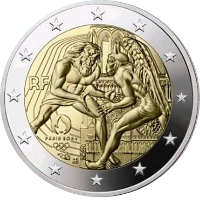
|
 |
France | Herkules and the wrestling match ‐ Notre Dame 4th coin in the series on the Olympic Summer Games Paris 2024 |
20003 |  |
Volume : 510,000 Date of Issue : 09 Jan. 2024 Designer : Joaquin Jimenez (Mintmark = a square) Producer : French mint Monnaie de Paris in Plessac (Mintmark = cornucopia) |
|||||
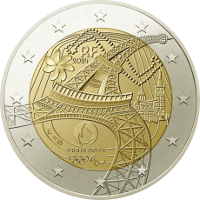
|
 |
France | Olympic and Paraolympic Games in Paris 2024 | 20003 |  |
Volume : 24,034,000 Date of Issue : 04 Jun. 2024 Designer : Joaquin Jimenez (Mintmark = a square) Producer : French mint Monnaie de Paris in Plessac (Mintmark = cornucopia) |
|||||
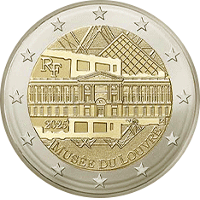
|
 |
France | Louvre Museem in Paris | 20003 |  |
Volume : 315,000 Date of Issue : 18 Mar. 2025 Designer : Joaquin Jimenez (Mintmark = a square) Producer : French mint Monnaie de Paris in Plessac (Mintmark = cornucopia) |
|||||
| References : | |||
| 20001 | Images taken with authorisation by the ECB ‐ Mail dated 20.Feb.2020 © "European Central Bank" |
20002 | Not Applicable |
| 20003 | Images taken temporally from the Internet | 20004 | Not Applicable |
 |




